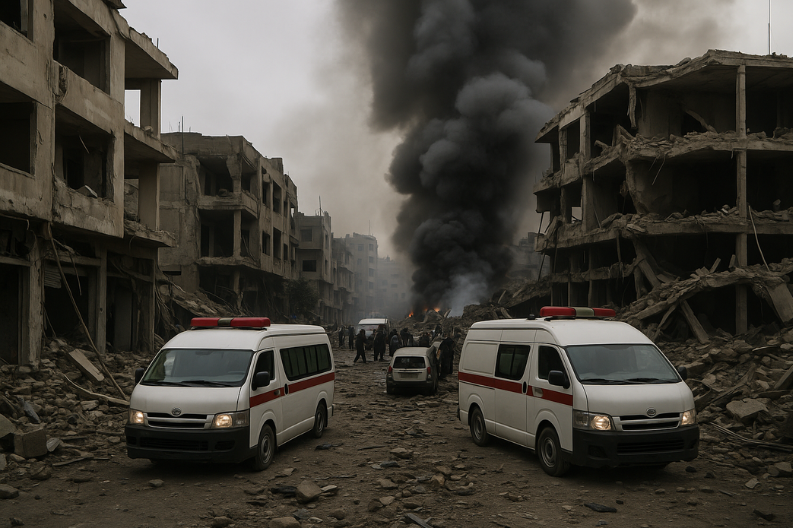Daily News
Lebanon Says Israeli Strike Near Palestinian Refugee Camp Kills 13

An Israeli Strike Near Palestinian Refugee Camp Kills 13 people in southern Lebanon, marking the deadliest attack since the ceasefire between Israel and Hezbollah began one year ago. The strike hit the Ein el-Hilweh camp near the coastal city of Sidon on Tuesday evening, sparking international concern about the fragile peace in the region.
Lebanon’s health ministry confirmed that at least 13 people died in the attack. Additionally, several others suffered injuries, and ambulances rushed them to nearby hospitals for treatment. The ministry urged local residents to donate blood to help the wounded survivors.
According to Lebanon’s state news agency, a drone initially targeted a car in the parking lot near the Khalid bin Al-Walid Mosque. Subsequently, three missiles struck both the mosque and the nearby Khalid bin Al-Walid Center. Videos from the scene showed emergency workers loading badly mangled bodies onto trucks while smoke billowed from the targeted area.
The Israeli Defense Forces stated they targeted a Hamas training compound in the Ein el-Hilweh area. Furthermore, military spokesperson Lt Col Avichay Adraee said the army would “continue to act forcefully against Hamas’s attempts to establish a foothold in Lebanon.” The IDF claimed the location served as a base for planning and carrying out attacks against Israel.
Moreover, Israel said it took measures to reduce civilian harm before the strike. These measures included using precision munitions, conducting aerial observations, and gathering intelligence information. However, the high death toll raised questions about the effectiveness of these precautions.
Hamas strongly rejected Israel’s claims about a training compound. The Palestinian group called the accusations “pure fabrication and lies” designed to justify the attack. Instead, Hamas stated the strike hit an “open sports field frequented by young men from the camp.”
The group emphasized that it maintains no military installations in Palestinian refugee camps throughout Lebanon. Therefore, Hamas condemned the strike as an unprovoked attack on civilians. Several witnesses from the camp supported Hamas’s version of events, describing the victims as young men who had gathered at a recreational area.
Ein el-Hilweh represents the largest Palestinian refugee camp in Lebanon. The overcrowded and densely packed camp houses an estimated population of more than 60,000 Palestinian refugees, although the actual number may be higher. Many families have lived there for generations since fleeing or being expelled from their homes during the creation of Israel in 1948.
The camp sits on the outskirts of Sidon, a historic coastal city approximately 40 kilometers south of Beirut. Its narrow streets and crowded conditions make it particularly vulnerable to air strikes. Consequently, any attack on the camp typically results in high casualties and widespread damage.
Hamas fighters in the area prevented journalists from reaching the scene immediately after the strike. Nevertheless, footage emerged showing ambulances rushing through the narrow streets as residents searched for survivors amid the destruction.
This attack marks the third Israeli strike on Lebanon on Tuesday alone. Earlier in the day, drone strikes targeted vehicles in Blida and Bint Jbeil, killing two additional civilians. Therefore, the total death toll for November 18, 2025, reached 15 people killed by Israeli forces.
Israel has regularly carried out air strikes on people and places in Lebanon since the ceasefire deal with Hezbollah. Most strikes have targeted Hezbollah positions, but Israel has also attacked Hamas members in the country. Several Hamas officials have died in Lebanese strikes since October 2023, including senior leaders.
The current tensions stem from the October 7, 2023, Hamas-led attack on southern Israel that killed approximately 1,200 people and resulted in 251 hostages being taken. Israel’s military response in Gaza has killed at least 69,483 Palestinians, according to the territory’s health ministry.
One day after the October 7 attack, Hezbollah began firing rockets at Israel in solidarity with Palestinians in Gaza. Israel responded with shelling and air strikes in Lebanon. The conflict escalated dramatically in late September 2024 when Israel launched an intense bombing campaign and ground incursion into southern Lebanon.
Lebanese authorities reported that Israel’s attacks killed about 4,000 people during the 13-month conflict, including many civilians. Furthermore, more than 1.2 million residents fled their homes. Israeli authorities said more than 80 soldiers and 47 civilians died in the hostilities.
Israel and Hezbollah agreed to a ceasefire in November 2024. However, violations have occurred regularly since then. The ceasefire deal did not address the situation with Hamas or other Palestinian groups operating in Lebanon.
The attack on Ein el-Hilweh has raised concerns about the stability of the ceasefire agreement. International observers worry that continued Israeli strikes could reignite the broader conflict. Meanwhile, Lebanese officials have protested what they describe as violations of Lebanese sovereignty.
The United Nations peacekeeping force in Lebanon (UNIFIL) continues monitoring the situation. However, the force has faced its own challenges, including an incident where Israeli forces reportedly fired on UNIFIL personnel near the border.
The Israeli strike near Palestinian refugee camp kills 13 incident highlights the ongoing tensions in the region despite the formal ceasefire. While Israel maintains it targets only militants, critics argue that strikes in densely populated civilian areas inevitably result in innocent casualties. The international community continues calling for restraint from all parties to prevent further escalation.
Daily News
Tragic Incident Man Dies After Being Run Over in Zirakpur
A tragic event occurred in Zirakpur, a fast-growing area in Mohali district, Punjab.

A man dies after being run over in Zirakpur following a heated argument among friends near Old Kalka Road. The tragic incident occurred when a drunken brawl turned deadly, leaving one person dead and a community shocked. Police have registered a case and launched an investigation into what they initially believe was a vehicular accident.
Harpreet Singh, a resident of Preet Colony in Zirakpur, died after his friend Sahil allegedly hit him with a car. The incident took place near the old bus stand on Old Kalka Road, a busy area in this rapidly developing suburb of Chandigarh. Therefore, the accident has raised serious concerns about road safety and the dangers of drinking and driving.
According to police reports, Harpreet and his brother Anil had gone to a liquor vend where their friend Sahil joined them. The three friends started drinking together, but the gathering soon turned sour. Subsequently, an argument broke out among them, though the exact cause of the dispute remains unclear. Police are investigating what triggered the confrontation that led to such a tragic outcome.
After the argument intensified, Harpreet and his brother Anil decided to leave the liquor vend on foot. However, Sahil followed them in his car, a Maruti Suzuki Ertiga. The situation escalated dramatically when they reached near the old bus stand. Witnesses reported that Sahil’s car struck Harpreet with considerable force.
Passersby immediately rushed to help the injured man. They quickly took Harpreet to a nearby hospital for emergency treatment. Nevertheless, doctors declared him dead upon arrival. The victim’s family has demanded a thorough investigation, suspecting foul play rather than a simple accident.
Zirakpur Station House Officer (SHO) Satinder Singh confirmed that police have registered an accident case. Additionally, investigators have filed charges against Sahil under Sections 281 and 106 of the Bharatiya Nyaya Sanhita. These legal provisions deal with dangerous driving and causing death by negligence.
The police stated that their initial investigation suggests the incident was an accident. However, they are continuing to probe the matter from all angles. Furthermore, investigating officer Jaswant Singh and his team are reviewing CCTV footage from nearby shops and establishments to understand the complete sequence of events.
The victim’s family strongly believes this was not a simple accident. They have pointed out the suspicious circumstances surrounding the incident. Moreover, they want authorities to investigate whether Sahil intentionally ran over Harpreet following their argument. The family seeks justice and wants the truth to come out during the investigation.
Zirakpur has experienced rapid urbanization in recent years. The suburb now houses an estimated population of more than 100,000 residents. Consequently, the area has seen increased commercial activity, including numerous liquor vends, bars, and nightlife establishments. This growth has brought prosperity but also new challenges related to public safety.
The incident highlights growing concerns about alcohol-related accidents in the region. Statistics show that drunk driving contributes to a significant percentage of road accidents in Punjab. Therefore, traffic police regularly conduct awareness campaigns about the dangers of mixing alcohol with driving. Despite these efforts, incidents like this continue to occur.
Harpreet’s background has also emerged during the investigation. He had recently been released from jail after serving time for his involvement in vandalizing a hotel in Zirakpur. In July 2024, he was arrested along with others for their participation in hotel vandalism linked to extortion attempts. This criminal history has added another layer of complexity to the case.
The hotel vandalism case was part of a larger pattern of extortion and gang-related activities in Zirakpur. Several groups have been involved in demanding protection money from local businesses. Consequently, multiple arrests have been made over the past year as authorities crack down on organized crime in the area.
Local residents have expressed shock and concern following this incident. Many people knew both Harpreet and Sahil from the neighborhood. Additionally, community members are calling for stricter enforcement of drunk driving laws and better safety measures at liquor vends. They believe that establishments selling alcohol should take more responsibility for preventing customers from driving while intoxicated.
The Zirakpur police are continuing their search for Sahil, who fled the scene immediately after the incident. Meanwhile, authorities have issued alerts to nearby police stations and have set up checkpoints to locate the accused. They are also questioning other friends who may have information about what happened that night.
Traffic experts emphasize that responsible behavior regarding alcohol consumption is essential for preventing such tragedies. Furthermore, they recommend that friends designate a sober driver before starting to drink. Ride-sharing services and taxi options are readily available in Zirakpur, making it unnecessary to drive after consuming alcohol.
This case also raises questions about the role of liquor vendors in ensuring customer safety. Some community activists argue that vendors should take partial responsibility when they allow customers to leave intoxicated and then drive. However, others argue that personal responsibility remains the primary factor in preventing drunk driving incidents.
The Punjab government has implemented several measures to reduce alcohol-related accidents. These include stricter penalties for drunk driving, mandatory breath analyzer tests at checkpoints, and awareness campaigns in schools and colleges. Nevertheless, enforcement remains a challenge, especially in rapidly growing areas like Zirakpur, where infrastructure struggles to keep pace with population growth.
As the investigation continues, the incident serves as a stark reminder of how quickly a friendly gathering can turn into a tragedy. The man dies after being run over in Zirakpur case underscores the importance of making responsible choices, especially when alcohol is involved. As authorities investigate whether the incident was an accident or something more deliberate, the community mourns the loss of a life and calls for justice. People also recognize that they must stay vigilant, push for stronger enforcement, and take personal responsibility if they want to prevent tragedies like this in the future.
Daily News
Chandigarh Can Now Approve Repairs and Purchases Up to ₹100 Crore
Chandigarh is making important changes in how it handles repairs and purchases.

Chandigarh can now approve repairs and purchases up to certain limits following recent clarifications from the Ministry of Home Affairs (MHA). The Union Territory administration has regained authority to handle minor civil, electrical, and maintenance works without seeking approval from the central government. However, the situation remains complex after months of administrative confusion.
The MHA issued fresh clarifications on November 18, 2025, regarding financial and administrative powers delegated to Union Territories, including Chandigarh. Therefore, the UT Administration no longer needs to send proposals for minor civil and electric works, repairs, and maintenance to the ministry for approval. This change aims to speed up local decision-making and reduce bureaucratic delays.
Nevertheless, all proposals for new projects and schemes must still go to the ministry for necessary approvals. The ongoing works approved under any existing project or scheme will not face any impact from this clarification. Additionally, the MHA stated that this distinction between routine maintenance and new initiatives would help streamline the administrative process.
The recent clarification follows months of confusion that began in September 2025. At that time, UT Administrator Gulab Chand Kataria revised financial powers, overturning a May order that had enhanced the financial powers of UT officers. Consequently, the Centre assumed control over the sanctioning and tendering of most schemes and projects.
Previously, the administration had powers to approve projects up to Rs 100 crore. However, after the September order, even relatively small expenditures of over Rs 1.5 crore required MHA’s clearance. This dramatic reduction created significant bottlenecks in day-to-day operations across various departments.
For normal tenders without negotiations, the Chief Secretary retains financial powers up to Rs 100 crore, the Secretary Rs 30 crore, and heads of departments Rs 4 crore. Moreover, the May 9 order had enhanced the powers of heads of departments from Rs 2 crore to Rs 4 crore for open or limited tenders. Similarly, it increased secretaries’ powers from Rs 15 crore to Rs 30 crore.
The technical sanction powers for special repairs and original works were not altered during these changes. However, for works involving negotiations or consultancy, the ministry’s approval became mandatory. Furthermore, this requirement added another layer of complexity to the approval process.
The September order created widespread confusion among UT officials. Many department heads felt uncertain about their authority to approve even small projects worth just a few lakhs. Therefore, several critical administrative tasks came to a grinding halt, affecting multiple sectors across Chandigarh.
The engineering department stopped issuing tenders completely after the September changes. Records show that the last tender appeared on October 1, 2025. Since then, no new tenders have been issued, causing a significant break in the department’s workflow. Consequently, several infrastructure projects faced indefinite delays.
The disruption extended beyond construction projects and hit critical sectors, especially healthcare. Delays in tender approvals meant that medicine procurement for government hospitals also stalled. This situation raised serious concerns about potential drug shortages in public hospitals. Additionally, patients who rely on these medicines for treatment faced uncertainty about availability.
Other essential services also experienced interruptions. For instance, the Chandigarh Transport Undertaking (CTU) found it difficult to proceed with plans for purchasing new buses. Similarly, minor road repairs that would typically receive quick approvals got stuck in the bureaucratic maze.
The confusion particularly affected projects in the Rs 1.5 crore to Rs 10 crore range. Officials remained unsure whether these required central government approval or could be processed locally. Meanwhile, the lack of clarity prevented them from moving forward with urgent repairs and purchases that the city needed.
The November 18 clarification attempts to resolve these issues by clearly distinguishing between routine maintenance work and new projects. According to the new guidelines, maintenance and repair work can proceed without central approval, regardless of cost. However, any proposal for a completely new project or scheme still requires MHA approval.
This distinction should help the UT Administration handle day-to-day operations more efficiently. For example, road repairs, building maintenance, and electrical work can now receive faster approvals. On the other hand, ambitious new initiatives like constructing new schools or launching major infrastructure projects will still need central government oversight.
The Chandigarh Housing Board’s schemes continue to require proposals submitted to the Central Government. This ensures that larger housing projects receive the necessary scrutiny and oversight from higher authorities. Similarly, other major development initiatives must follow the same approval process.
Administrative experts suggest that finding the right balance between local autonomy and central oversight remains crucial. While local decision-making can speed up routine work, certain large-scale projects benefit from central government review. Therefore, the new guidelines attempt to strike this balance by differentiating between project types.
The changes also highlight broader challenges facing Union Territories in India. Unlike states with their own elected governments, UTs depend heavily on the central government for major decisions. Consequently, any changes in the delegation of powers can significantly impact their administrative efficiency.
Looking ahead, the UT Administration hopes the November clarification will restore normalcy to government operations. Officials expect that stalled tenders will resume shortly, allowing pending projects to move forward. Furthermore, the healthcare sector should see improvements in medicine procurement as approval processes become clearer.
Chandigarh can now approve repairs and purchases up to reasonable limits for routine work, though the exact financial ceilings for different categories of maintenance work remain subject to existing delegation rules. While the recent clarification provides much-needed relief, administrators must now work to rebuild the momentum lost during the months of confusion. Only through careful implementation of these new guidelines can Chandigarh achieve the efficiency it needs while maintaining appropriate oversight for major projects.
Daily News
Chandigarh Introduces New Traffic Violations Reporting App
Chandigarh is working on a new app to help report traffic violations.

The Chandigarh introduces new traffic violations reporting app initiative is moving forward as the city works on a new digital tool to help people report traffic problems safely. Inspired by Delhi’s successful traffic reporting app, Chandigarh aims to improve road safety and make it easier for citizens to share information without fear. Since many people avoid confronting unsafe drivers directly, the new app gives them a safer way to help the police.
Although Chandigarh took ideas from Delhi’s updated app released on September 1, 2024, the new version will not include Delhi’s money reward feature. Delhi offers up to ₹50,000 to users who report violations. However, Chandigarh officials believe that even without cash rewards, people will still participate because they want safer roads for everyone.
The app’s main purpose is to reduce road accidents by encouraging responsible driving. Because road safety affects everyone—drivers, walkers, and cyclists—the city wants a tool that helps the police respond quickly. Moreover, the app will use GPS tracking, which means it will automatically record the exact location of violations. This saves time and helps officers reach the right spot faster.
Since many users prefer to stay anonymous, Chandigarh’s app will allow people to report violations without revealing their names. This feature protects citizens and encourages more honest reporting. As a result, people can support law enforcement without facing any personal risk or arguments with offenders.
Chandigarh faces road safety challenges because it is a busy and well-connected city. With visitors, students, and daily commuters filling the streets, the number of vehicles keeps increasing. Because of this constant growth, better traffic monitoring is necessary to avoid accidents and improve order on the roads.
Across India, road safety remains a serious concern. The Ministry of Road Transport and Highways reported around 1.5 lakh road accident deaths in a single year. These numbers show why improved reporting systems and community participation are important. Cities like Chandigarh want to reduce such tragedies through better technology, stronger awareness, and easier ways to report issues.
Although the app is still being developed, the Chandigarh Traffic Police are working carefully to ensure accuracy, smooth performance, and a simple layout. They want the app to be easy for everyone—including older adults and new smartphone users. A clean menu and simple buttons will help users report violations quickly.
The app will also guide people on common road rules. While reporting violations, users may learn about safe driving practices like lane discipline, speed limits, and pedestrian rights. Because of this, the app becomes not just a reporting tool but also an educational tool for the public.
Expected features include:
• Anonymous reporting for user safety
• GPS-based location capture
• A clean and simple design
• Photo and video upload options
• Real-time status updates on reported cases
Furthermore, the police plan to use the collected data to understand which areas face the most issues. This information will help them increase patrols, fix road layout problems, and manage traffic more effectively. Over time, these improvements can reduce daily congestion and accident risk.
Community participation will play a big role in the app’s success. When more people report wrong parking, rash driving, or signal jumping, the police can respond faster. Additionally, residents will feel more responsible for their neighborhood’s safety. Even small steps—like following speed limits or stopping at pedestrian crossings—help create safer roads.
Authorities are also considering future updates to the app. These may include alerts about heavy traffic, accident zones, or road closures. With time, the app may also connect to emergency services, giving users quick access to help during road incidents.
Although the app will not offer cash rewards like Delhi’s, the long-term benefit is far greater. A safer city protects lives, reduces medical emergencies, and builds a more responsible driving culture. In a growing city like Chandigarh, this digital tool can make a meaningful difference.
In conclusion, the Chandigarh introduces new traffic violations reporting ap project marks an important step toward a safer traffic system. With simple features, anonymous reporting, accurate GPS tracking, and community involvement, the app aims to reduce violations and improve road behavior. While the city works on finalizing the app, residents can look forward to a smarter and safer way to support traffic enforcement.
-

 Entertainment2 years ago
Entertainment2 years agoTop 15 Punjabi Models – Male and Female List
-

 City Guide2 years ago
City Guide2 years ago3B2 Mohali Market Shops: Discover 44 Hidden Gems
-

 Entertainment2 years ago
Entertainment2 years agoTop 11 Punjabi Comedians of All Time
-

 Jobs4 years ago
Jobs4 years agoTop 20 IT Companies in Mohali
-

 Food4 years ago
Food4 years ago11 Best Restaurants in Mohali You Must Visit
-

 Property2 years ago
Property2 years agoWho Lives In Homeland Mohali: Punjabi Celebrities, Business People…
-

 Food3 years ago
Food3 years agoTop 15 Cafes in Mohali you must visit
-

 Education2 years ago
Education2 years ago10 Famous Punjabi Writers With A Great Impact On The Literary World
